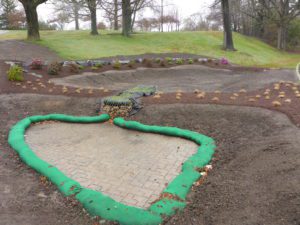By: Kristen Curry
As hundreds and thousands of visitors visit Roger Williams Park on a typical day, most don’t stop to think about the water also coming in and out on a daily basis. Though this water flows in and out with little fanfare, there is cause for celebration.
Thanks to the hard work of the Providence Parks Department and the Providence Stormwater Innovation Center, recent data indicate that the water flowing out of the park is cleaner than when it comes in. The news was shared in a report delivered by Dr. James Houle, Director of the University of New Hampshire Stormwater Center, who conducted a water quality report based on real-time monitoring in the park.
Old waterways, new approaches
Park personnel grapple with the fact that while the water in the park is now cleaner, issues in the large watershed remain, according to Brian Byrnes, Deputy Superintendent of Providence Parks.
The primary way water comes into Roger Williams Park is via the Mashapaug Pipe which runs from Mashapaug Pond in Providence’s Reservoir neighborhood, to Roosevelt Lake near the Casino and Bandstand. Water leaves the park below Cunliff Lake at Park Avenue and flows into the Pawtuxet River less than one mile downstream.

According to a recent study the water leaving the park at Park Avenue is cleaner than when it enters the park at Roosevelt Lake.
Like many cities, some water pollution originates from a legacy of industrial activities. The Gorham plant, in nearby Elmwood, produced beautiful silver shipped around the world but left a dirty footprint on Mashapaug Pond. Since the plant closed in 1986, millions have been spent to address contamination in Mashapaug Pond. Still, levels of phosphorus and nitrogen continue to be higher than healthy in Mashapaug.
A 2010 report led the way in starting today’s work, when the Rhode Island Department of Environmental Management asked the Parks Department to reduce phosphorus pollution in Roger Williams Park ponds by 85%. Preventing improper use of the Mashapaug Pipe is one way to maintain healthy park ponds, says Brian, who cites how one laundry detergent pod produces 100 pounds of phosphorus pollution. “A lot from it can come from laundry,” says Brian, “parking lots, salt, sand, fertilizer, geese guano, all sorts of things.”
Brian and his cohorts speak a special language of acronyms and numbers (TP, BMP, etc.) as they assess the waterways. For example, each waterway has a “TMDL” rating, assessing the total allowable pollution load for each body of water. Brian knows water well, having worked on many stormwater water projects as a contractor working in the city for 26 years before assuming his current role with the Parks Department in 2015. In Brian’s seven years with Parks, the Parks Department has spent $1.5m in capital improvement funds to clean up its water. And park visitors have noticed. “We hear from people every day, thanking us for bringing the park back to the way it used to be. I do think we’ve made a difference and the data shows that improvement.”
The water in the park is not only an environmental issue but a public safety one. “We need to make the water as safe as it can be,” Brian says.
Local progress, larger problems
Roger Williams Park is also home to the Providence Stormwater Innovation Center, developed to help address the park’s water issues.
Cyanobacteria, also known as blue-green algae, are a type of organism found naturally in all water bodies. Though they are able to use sunlight to make their own food, cyanobacteria also need nutrients like nitrogen and phosphorus in order to grow. In warm, nutrient-rich water, cyanobacteria can reproduce quickly and spread across the water’s surface, forming blooms. Some cyanobacteria can produce cyanotoxins, a powerful poison. Cyanobacteria and phosphorus can make people and animals very sick if they come in contact with them. As the ponds are primarily manmade and shallow, their water warms easily, creating a perfect petri dish for cyanobacteria.
Algae growth has long been a chronic problem in the park’s lakes. Even in the 1920s, park workers were charged with dragging vegetation from the lakes to tackle the problem. Over the years, lack of maintenance and understanding worsened the situation. Years ago, park staff used to push leaves into the water each fall, leading to phosphorus and nitrogen build-up.
In addition to reducing pollution from Mashapaug Pond, the Providence Parks Department built 43 rain gardens, sand filters and other “green infrastructure” to reduce the toxic bloom. This nature-based approach improves water quality, and offers beautification and wildlife benefits as well. In essence, green infrastructure takes untreated water and puts it through natural filters.

“Green Infrastructure” built by the Providence Parks Department reduces water pollution in adjacent Polo Lake
As a result, according to Dr. Houle, water exiting Roger Williams Park is now cleaner than when it enters. However, the pond pollutants did not arrive overnight and they won’t leave overnight either. Ryan Kopp, coordinator of the Stormwater Innovation Center, comments, “It’s a long process, not instantaneous. More work needs to be done upstream of Roger Williams Park to prevent further blooms. It’s a long-term battle.”
The recent turnaround, at least within the park, shows that mitigation methods can work in a fairly rapid amount of time. Brian feels that clean water in the park is a goal within reach.
One way the park is planning to draw attention to its water sources is to use some of its historic sites to showcase the work. The Seal House, for instance, will soon have a kiosk for public viewing. And students from Cranston and Providence are a key part of the ongoing work, says Brian. “They’re our future. Kids today have a much better understanding of water and other environmental issues than we did.”
Learn more about the pond restoration work in Roger Williams Park, and how to get involved, at www.stormwaterinnovation.org.
